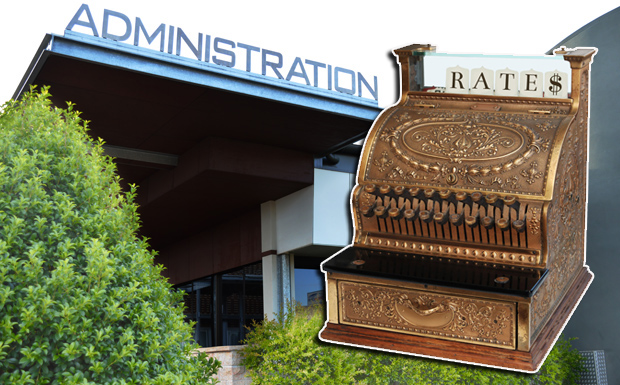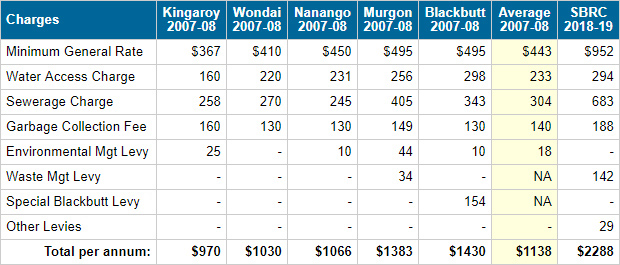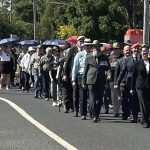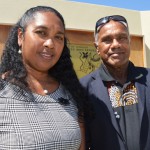
September 7, 2018
by Dafyd Martindale
Average rate bills in the South Burnett have doubled in the decade since the 2008 council amalgamations while CPI over the same period has risen by just 24 per cent.
Five years ago, southburnett.com.au compared the rates charged by all the South Burnett’s former councils (ie Nanango, Kingaroy, Wondai and Murgon) in the year before amalgamation with the South Burnett Regional Council’s rates in 2013-14.
Since rates can vary widely from one property to another depending on a block’s size and value, water consumption, number of toilet pedestals etc) we used the minimum general rate plus minimum fixed charges (ie water and sewerage connection charges and waste collection fees) plus any levies charged by the former councils to make our comparison.
Our study showed while rates had risen over the six years between 2007 and 2013, the increase amounted to about $297 for an average town or rural residential block in Blackbutt and Murgon, $661 for Nanango, $697 for Wondai and $757 for Kingaroy.
Or in other words, annual increases of between $50 and $126 per year for six years in a row.
However, our 2013 study did not include the $200 per annum Road Levy because – at that time – it was believed to be a temporary surcharge.
Fast forward five years to the 2018-19 Budget and the Road Levy has become a permanent extra charge merged into the General Rate, along with the Environmental Management Levy.
So we thought we’d do the comparison again:
Comparison of Rates and Charges 2007-2008 v. 2018-2019

What We Found
What we found is that on average, rates in the South Burnett have doubled in the 10 years since the South Burnett Regional Council came into existence.
If our mythical “average” property paid about $1100 in rates in 2008, the owners now pay about $2200 in 2018 and can probably expect to pay $4400 a year by 2028 if nothing changes.
This means most residents have been seeing their rates bill grow by an average 7.2 per cent per year over the past decade, which is triple the average 2.4 per cent annual CPI increase during that time, and slightly less than twice average weekly earnings growth of 3.8 per cent.
However, in reality these rises have not been even.
In the first few years after amalgamation, the Council raised rates substantially (9 per cent in 2008-09 and 7.5 per cent in 2009-10).
This was followed by four years of mid-range rises (5 per cent in 2010-11; 4.3 per cent in 2011-12; 5.75 per cent in 2012-13; and 5.8 per cent in 2013-14).
Collectively, these rises – and increases in some fixed charges – allowed the Council to move from a “weak” financial position in 2008 to a “moderate” one by early 2015.
But the past four years have seen much lower increases (2.75 per cent in 2014-15 and 2015-16; 2.5 per cent in 2016-17 and 2017-18).
The Council has attributed this to cost cutting and operational efficiencies, and this is partly true.
The Hidden 16pc Rate Rise
The biggest contributor to lower rate increases over the past four years was the introduction of the $200 a year Road Levy in the 2013-14 Budget.
This raised an extra $3.2 million a year for Council, which was equivalent to a rate rise of 16 per cent.
It was this levy that probably allowed Council to hand down much lower general rate increases over the past four years.
Ratepayers hit by the Council’s sudden switch in the latest Budget to a valuation-based rating system that incorporates the levy into the general rate are understandably upset about the rises they’re seeing this year.
The change has added an extra 8 to 17 per cent to some rates bills at a time when many rural property owners – some of the hardest hit – have uncertain incomes due to drought.
Council has since admitted it did a poor job of communicating with affected rural residents about the change before handing down this year’s Budget, and has extended the normal 30-day discount period for the August rates notices by an extra six weeks as compensation.
The ratepayers group which was formed after protest meetings at Durong has launched a letter-writing campaign to Council, and AgForce Queensland representative Carolyn Stone has been advocating on behalf of rural ratepayers.
But Council says that now the Budget has been passed, the rates component cannot be changed.
Acting Mayor Kathy Duff told the media on August 24: “Unfortunately the legislation says once a Budget has been announced we cannot change it.”
- Related article: Your Rates: How They Have Risen
























Can you do a similar study on councillor pay rates over the same period? Thanks.
Good explanation Dafyd… but you forgot to add in that property values have dropped by up to 50 per cent but then the local govt authorities upped the rate costs to match…😎🤑🤑🤑😭
Leigh: The salaries of all Queensland’s Mayors, Deputy Mayors and Councillors (except Brisbane City Council) have been set by the Local Government Remuneration and Discipline Tribunal since amalgamation. Each year the Tribunal brings down its wage determination on December 1 to take effect from January 1, and all Councils have to formally adopt it by February 1.
Salaries are largely tied to the population of a Council area. There were originally nine categories, which have now been reduced to eight. The South Burnett was originally graded as a Category 4 Council and is now graded a Category 3 council (ie not very big).
In 2008, the Tribunal set the salaries of the Mayor, Deputy and Councillors for Category 4 councils in a range, allowing those Councils to pay their Mayor anything between $88,590 and $107,580; their Deputy $53,790 to $69,610; and Councillors $44,300 through to $60,120.
Over the past decade the Tribunal has changed this system slightly and now just issues one rate for Mayors, Deputy Mayors and Councillors. Currently, the Mayor receives $127,898; Deputy Mayor $71,943; and Councillors $67,945.
We do not have any information about what local Councillors were paid in 2008 – we believe they voted to take something mid-way along the pay range the Tribunal set – but if we assume they took the highest rate they were entitled to, then the Mayor’s salary has risen by $20,318, the Deputy Mayor’s salary by $2333 and Councillor salaries by $7825 over the past decade.
So what your saying is performance is a non-issue that is left for voters to decide. Unfortunately we have to fill a position even if there is no qualified person to vote for, just like in State and Federal elections. Democracy, don’t you just love it.
Performance is a non-issue to South Burnett Regional Councillors. Look up their stated vision and it confirms Cr Duff’s admission that council failed badly in it’s communication with ratepayers who are the key stakeholders. Worse still, they now have a Communications Officer to cover their mistakes. Does that officer’s salary come out of reduced councillor”s pay or does the ratepayer get hit again?